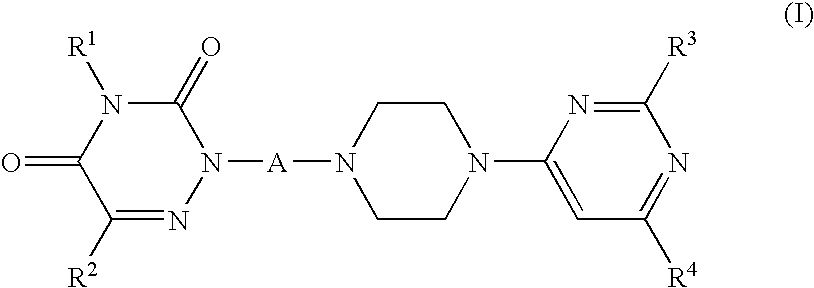1,2,4,-triazin-3,5-dione compounds suitable for treating disorders that respond to modulation of the dopamine d3 receptor
a technology of triazine and d3 receptor, which is applied in the field of new drugs, can solve the problems of unsatisfactory selectivity of compounds towards d3 receptors and unfavorable dmpk profiles, and achieves favorable dmpk profiles and selective binding high
- Summary
- Abstract
- Description
- Claims
- Application Information
AI Technical Summary
Benefits of technology
Problems solved by technology
Method used
Image
Examples
preparation examples
I. Preparation of Intermediate Compounds II
preparation example 1
3,5-Bis-trimethylsilanyloxy-[1,2,4]triazine
[0126]
[0127]1.7 mL of trimethylchlorosilane (13.27 mmol) were added with stirring to a mixture of 15 g (133 mmol) of 2H-[1,2,4]triazine-3,5-dione and 74.7 mL of hexamethyldisilazane (358 mmol). The mixture was stirred for 2 h under reflux, and excess of reagents removed in high vacuo. The forming white solid was directly used in the next step.
[0128]1H-NMR (DMSO-d6, 400 MHz): δ [ppm] 7.35 (s, 1H), −0.05 (s, 18H).
preparation example 2
2-(4-Chloro-butyl)-2H-[1,2,4]triazine-3,5-dione
[0129]
[0130]22.1 g of 3,5-Bis-trimethylsilanyloxy-[1,2,4]triazine (86 mmol) were dissolved in 150 mL of dichloroethane followed by addition of 14.7 g of 1-bromo-4-chloro-butane (86 mmol) and 0.218 g of iodine (0.858 mmol). The reaction mixture was stirred for 25 h at room temperature. Then, 300 mL of methanol were added and the mixture was stirred for an additional 10 minutes. The solvents were evaporated under reduced pressure and the residue was partitioned between dichloromethane and water. The aqueous phase was extracted several times with dichloromethane. The combined organic layers were washed with 10% aqueous sodium bicarbonate solution and saturated aqueous sodium chloride solution, dried over sodium sulfate, filtered, and the organic phase was evaporated under reduced pressure. The thus obtained crude product was purified via silica gel chromatography using dichloromethane-methanol 0-10% to yield 13.4 g of the desired product.
[...
PUM
| Property | Measurement | Unit |
|---|---|---|
| concentration | aaaaa | aaaaa |
| pH | aaaaa | aaaaa |
| chain length | aaaaa | aaaaa |
Abstract
Description
Claims
Application Information
 Login to View More
Login to View More - R&D
- Intellectual Property
- Life Sciences
- Materials
- Tech Scout
- Unparalleled Data Quality
- Higher Quality Content
- 60% Fewer Hallucinations
Browse by: Latest US Patents, China's latest patents, Technical Efficacy Thesaurus, Application Domain, Technology Topic, Popular Technical Reports.
© 2025 PatSnap. All rights reserved.Legal|Privacy policy|Modern Slavery Act Transparency Statement|Sitemap|About US| Contact US: help@patsnap.com



